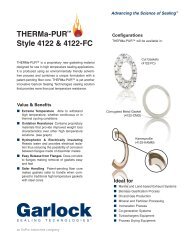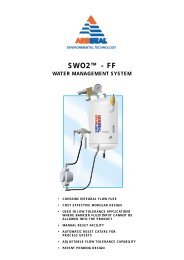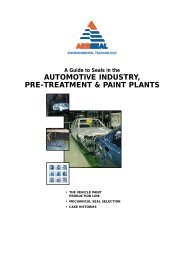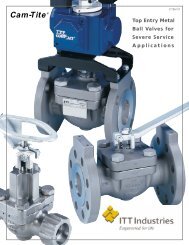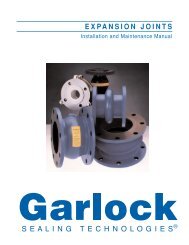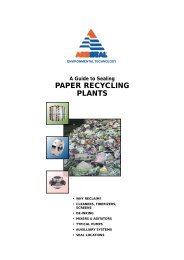Engineered Gasketing Products - RevBase
Engineered Gasketing Products - RevBase
Engineered Gasketing Products - RevBase
You also want an ePaper? Increase the reach of your titles
YUMPU automatically turns print PDFs into web optimized ePapers that Google loves.
Temperature<br />
In most selection processes, the temperature of the fluid at<br />
the gasketed joint should be considered first. This will reduce<br />
the number of product candidates quickly, especially as temperatures<br />
go from 200°F (95°C) to 1,000°F (540°C). When<br />
system operating temperatures approach a particular gasket<br />
material’s maximum continuous operating temperature limit,<br />
an upgrade to a superior material is suggested. In some situations<br />
cryogenic temperatures must also be considered.<br />
Application<br />
The most important information under Application is the type<br />
of flange and bolts used. The number, size and grade of<br />
bolts used in the application determines the load available.<br />
The surface area being compressed is calculated from the<br />
gasket contact dimensions. The load from the bolts and the<br />
contact area of the gasket result in the compressive load<br />
available to seal the gasket. We have calculated and tabulated<br />
this information on standard ANSI raised face flanges<br />
(see page C-45). Compressive stress available on nonstandard<br />
flanges must be calculated on an individual basis.<br />
Without this information, we cannot choose between various<br />
types of materials such as elastomeric (rubber) gaskets,<br />
compressed sheet, GRAPH-LOCK ® and GYLON ® styles.<br />
Media<br />
There are thousands of different fluids. We cannot, in this<br />
manual, make recommendations for all fluids. Fortunately,<br />
however, there are a relatively limited number of fluids that<br />
make up the vast majority of the media encountered in industry.<br />
A general overview of fluid compatibility is provided for<br />
the most popular styles shown in this manual (see Chemical<br />
Resistance chart, pages C-26 to C-38). System clean out<br />
and flushes should also be considered. Additional information<br />
on products versus fluids is available upon request.<br />
Pressure<br />
Next to be considered is the internal pressure of the fluid<br />
at the gasketed joint. We list the maximum pressure limits<br />
for each style. If severe and frequent pressure changes are<br />
involved, we should be given the details, since an alternative<br />
product may be needed.<br />
Pressure (psi or bar) x Temperature (°F or °C)<br />
We strongly recommend that pressure and temperature<br />
be considered simultaneously by using the following procedure:<br />
1. First select the Garlock style(s) being considered for<br />
your application/service,<br />
2. List the maximum pressure, temperature and P x T value<br />
for the style(s),<br />
3. Make sure the actual service conditions do not exceed<br />
the style limitations in any of the three criteria. If they<br />
don’t, the style(s) can be used, provided all other requirements<br />
are met. If they do exceed any one limit, another<br />
style or styles should be considered. Rarely can a style<br />
be recommended when the service conditions of pressure<br />
and temperature are both at the maximum limits<br />
for that style.<br />
Example: BLUE-GARD ® <strong>Gasketing</strong> Style 3000<br />
Compressed Asbestos-free<br />
1. Pressure Limit: 1,000 psig (70 bar)<br />
2. Maximum Temperature Limit: 700°F (370°C);<br />
Continuous Operating Temp.: 400°F (205°C)<br />
3. P x T Limit: 350,000* (12,000)<br />
At 1,000 psig (70 bar), maximum temperature is 350°F<br />
(180°C).<br />
Important<br />
Maximum pressure and P x T ratings are based on<br />
the use of ANSI RF flanges at our preferred torque.<br />
The ratings were developed using laboratory tests<br />
at ideal gasketing conditions. Field conditions will<br />
undoubtedly affect the gasket performance.<br />
When approaching maximum pressure, continuous<br />
operating temperature, minimum temperature or<br />
50% of maximum PxT, consult Garlock Applications<br />
Engineering.<br />
We hasten to point out that this method for gasket selection<br />
is merely a general guide and should not be the sole<br />
means for selecting or rejecting a product.<br />
* P x T based on 1/16" sheet thickness unless otherwise stated.<br />
Garlock<br />
Gaskets<br />
®<br />
C-23



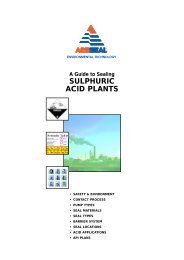
![VCS Flange Gasket [1.03 MB] - AR Thomson Group](https://img.yumpu.com/12044617/1/190x245/vcs-flange-gasket-103-mb-ar-thomson-group.jpg?quality=85)

![PGE Flange Gasket Product Brochure [1.04 MB] - AR Thomson Group](https://img.yumpu.com/12044595/1/190x245/pge-flange-gasket-product-brochure-104-mb-ar-thomson-group.jpg?quality=85)
